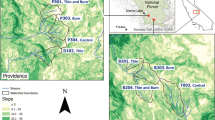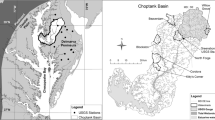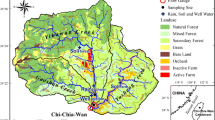Abstract
For this study, characteristics and trends of the chemical constituents in bulk precipitation and streamwater were observed in a small mountainous watershed on the Shikoku Island of Japan, which covered an area of 27.4 hectares. Bulk precipitation and streamwater chemistry data spans from May 1997 to October 2004, and January 1996 to October 2004, respectively. The data were tested for two types of trends: (1) a monotonic trend to determine if concentrations of the chemical constituents were generally decreasing, increasing, or stable during the study period, and (2) a step trend to determine if a change occurred following the December 1999-January 2000 forest thinning. Both parametric and non-parametric statistical analyses were carried out in this study. Although the study area is only 35 km away from the Pacific Ocean, bulk precipitation chemistry was also influenced by terrestrial sources to a large extent. Streamwater chemistry was influenced by bedrock weathering, which was dominated by Ca2+ and HCO3−, and was not strongly related top recipitation chemistry.Non−parametric Seasonal Kendall Test(SKT)showedadeceasingtr end of Ca 2+ and anincreasing tr end of K + in bulk precipitation.Despite the decreasing trend of Mg 2+, an increasing trend of pH was found in the stream water.Non−paramet ric Mann−Whit ney−Wilcoxon Rank Sum test showed statistically sign if icantin creases of NO 3− and Ca 2+ in stream water followed by a moderate thinning operation.
Similar content being viewed by others
References
Bäumler, R., & Zech, W. (1999). Effects of forest thinning on the streamwater chemistry of two forest watersheds in the Bavarian Alps. Forest Ecology and Management, 116, 119–128.
Berner, E.K., & Berner, R.A. (1987). The Global Water Cycle: Geochemistry and Environment. Englewood Cliffs, NJ: Prentice-Hall, 379 pp.
Blanchard, D.C., & Woodcock, A.H. (1980). The production, concentration and vertical distribution of the sea-salt aerosol. Annals of the New York Academy of Sciences, 338, 330–347.
Bonsang, B., Nguyen, B.C., Gaudry, A., & Lambert, G. (1980). Sulfate enrichment in marine aerosols owing to biogenic gaseous sulfur compounds. Journal of Geophysical Research, 85, 7410–7416.
Binkley, D., & Brown, T.C. (1993). Forest practices as nonpoint sources of pollution in North America. Water Resources Bulletin, 29(5), 729–740.
Bradley, J.V. (1968). Distribution-Free Statistical Tests. Englewood Cliffs, NJ: Prentice-Hall, 388 pp.
Carmichael, G.R., Streets, D.G., Calori, G., Amann, M., Jacobson, M.Z., Hansen, J., & Ueda, H. (2002). Changing trends in sulfur emissions in Asia: implications for acid deposition, air pollution, and climate. Environmental Science and Technology, 36(22), 4707–4713.
Childress, C.J.O., & Bathala, N. (1997). Water-quality trends for streams and reservoirs in the research triangle area of North Carolina. 1983–1995. U.S. Geological Survey Water-Resources Investigations Report 97–4061, 18 pp.
Cleveland, W.S. (1979). Robust locally weighted regression and smoothing scatterplots. Journal of the American Statistical Association, 74, 829–836.
Dow, C.L. (1999). Detecting base flow impacts in Coastal Plain streams. Journal of the American Water Resources Association, 35, 349–362.
Driscoll, C.T., Likens, G.E., Hedin, L.O., Eaton, J.S., & Borrmann, F.H. (1989). Changes in the chemistry of surface waters: 25 year results at the Hubbard Brook Experimental Forest, NH. Environmental Science and Technology, 23, 137–143.
Edmonds, R.L., & Blew, R.D. (1997). Trends in precipitation and stream chemistry in a pristine old-growth forest watershed, Olympic National Park, Washington. Journal of the American Water Resources Association, 33(4), 781–793.
Gibbons, J.D. (1992). Nonparametric Statistics: An Introduction. Thousand Oaks, CA: Sage Publications, 96 pp.
Hara, H. (1998). Acid deposition chemistry in Asia, Europe, and North America. Progress in Nuclear Energy, 32 (3/4), 331–338.
Hem, J.D. (1970). Study and interpretation of the chemical characteristics of natural water, 2nd ed., U.S. Geological Survey Water-Supply Paper 1473, 363 pp.
Hirsch, R.M., Slack, J.R., & Smith, R.A. (1982). Techniques of trend analysis for monthly water quality data. Water Resources Research, 18(1), 107–121.
Hirsch, R.M., Alexander, R.B., & Smith, R.A. (1991). Selection of methods for the detection and estimation of trends in water quality. Water Resources Research, 27(5), 808–813.
Hornbeck, J.W. (1992). Comparative impacts of forest harvest and acid precipitation on soil and streamwater quality. Environmental Pollution, 7(2/3), 151–155.
Ichikawa, Y., Hayami, H., & Fujita, S. (1996). Development of long-range transport models for East Asia. In Kohno, Y. (Ed.), Proceedings of CRIEPI International Seminar on Transport and Effects of Acidic Substances. Tokyo, Japan, November 1996, pp. 67–76.
Ikeda, H., & Miyanaga, Y. (1995). Mechanism of acid-neutralization in two Japanese watersheds. Water, Air and Soil Pollution, 85, 1867–1872.
Ikeda, H., & Miyanaga, Y. (2001). Comparison of acid neutralization by chemical weathering between acidified and non-acidified watersheds. Water, Air and Soil Pollution, 131, 407–436.
Inoue, K., Satake, H., Shima, T., & Yokota, N. (1991). Partial neutralization of acid rain by Asian eolian dust transported over long distance. Soil Science and Plant Nutrition, 37, 83–91.
Kahya, E., & Kalayc, S. (2004). Trend analysis of streamflow in Turkey. Journal of Hydrology, 289, 128–144.
Katoh, T., Konno, T., Koyama, I., Tsuruta, H., & Makino, H. (1990). Acidic Precipitation in Japan. In Bresser, A. H. M., & Salomons, W. (Eds.), Acidic Precipitation: International Overview and Assessment, vol. 5. Advances in Environmental Science, New York: Springer-Verlag, pp. 41–105.
Keene, W.C., Pszenny, A.A.P., Galloway, J.N., & Hawley, M.E. (1986). Sea-Salt corrections and interpretation of constituent ratios in marine precipitation. Journal of Geophysical Research, 91(D6), 6647–6658.
Lawrence, G.B., Fuller, R.D., & Driscoll, C.T. (1987). Release of Aluminum following Whole-Tree Harvesting at the Hubbard Brook Experimental Forest, New Hampshire. Journal of Environmental Quality, 16, 383–390.
Likens, G.E., & Bormann, F.H. (1995). Biogeochemistry of a Forested Ecosystem. 2nd ed., New York: Springer-Verlag, 159 pp.
Likens, G.E., Driscoll, C.T., Buso, D.C., Siccama, T.G., Johnson, C.E., Lovett, G.M., Fahey, T.J., Reiners, W.A., Ryan, D.F., Martin, C.W., & Bailey, S.W. (1998). The biogeochemistry of calcium at Hubbard Brook. Biogeochemistry, 41, 89–173.
Martin, C.W., Noel, D.S., & Federer, C.A. (1984). Effects of Forest Clearcutting in New England on Stream Chemistry. Journal of Environmental Quality, 13, 204–210.
Miller, J.H., & Newton, M. (1983). Nutrient loss from disturbed forest watersheds in Oregon's Coast Range. Agro-Ecosystems, 8, 153–167.
Mitchell, M.J., Iwatsubo, G., Ohrui, K., & Nakagawa, Y. (1997). Nitrogen saturation in Japanese forests: an evaluation. Forest Ecology and Management, 97, 39–51.
Mizota, C., & Matsuhisa, J. (1985). Eolian additions to soil and sediments in Japan. Soil Science and Plant Nutrition, 31, 369–382.
Murano, K., Mukai, H., Hatakeyama, S., Jang, E.S., & Uno, I. (2000). Trans-boundary air pollution over remote islands in Japan: observed data and estimates from a numerical model. Atmospheric Environment, 34, 5139–5149.
Ohte, N., & Tokuchi, N. (1999). Geographical variation of the acid buffering of vegetated catchments: factors determining the bicarbonate leaching. Global Biogeochemical Cycles, 13(4), 969–996.
Ohte, N., Tokuchi, N., & Suzuki, M. (1995). Biogeochemical influences on the determination of water chemistry in a temperate forest basin: factors determining the pH value. Water Resources Research, 31(11), 2823–2834.
Ohte, N., Tokuchi, N., Shibata, H., Tsujimura, M., Tanaka, T., & Mitchell, M.J. (2001). Hydrobiogeochemistry of forest ecosystems in Japan: major themes and research issues. Hydrological Processes, 15, 1771–1789.
Peters, N.E., Cerny, J., Havel, M., & Krejci, R. (1999). Temporal trends of bulk precipitation and stream water chemistry (1977–1997) in a small forested area, Krusné hory, northern Bohemia, Czeck Republic. Hydrological Processes, 13(17), 2721–2741.
Rahman, A.F.M.A. (2005). Effects of forest management practices on streamwater quality, runoff and erosion in small mountainous watersheds. Ph.D. dissertation, The United Graduate School of Agricultural Sciences, Ehime University, pp. 61–77.
Rahman, A.F.M.A., Yoshioka, T., & Hiura, H. (2002). Effects of thinning onrunoff and observation of the wash-load from a small mountainous watershed. InTsuchiya, S., & Maita, H. (Eds), Proceedings of the International Congresson Protection of Habitat Against Floods, Debris Flows and Avalanches, vol. 1.Japan: Matsumoto, October, 2002, pp. 67–77.
Rahman, A.F.M.A., Hiura, H., & Shino, K. (2005). Effects of forestry activitieson streamwater chemistry of a small mountainous sub-watershed at Serikawa RiverBasin on Shikoku Island, Japan. Japan Agricultural Research Quarterly, 39(3), 205–213.
Schulze, E.-D., DeVries, W., Hauhs, M., Rosen, K., Rasmussen, L., Tamm, C.-O., & Nilsson, J. (1989). Critical loads for nitrogen deposition on forest ecosystems.Water, Air and Soil Pollution, 48, 451–456.
Sen, P.K. (1968). Estimates of the regression coefficient based on Kendall's tau. Journal of the American Statistical Association, 63, 1379–1389.
Seto, S., Oohara, M., & Ikeda, Y. (2000). Analysis of precipitation chemistry at a rural site in Hiroshima Prefecture, Japan. Atmospheric Environment, 34, 621–628.
Seto, S., Nakamura, A., Noguchi, I., Ohizumi, T., Fukuzaki, N., Toyama, S., Maeda, M., Hayashi, K., & Hara, H. (2002). Annual and seasonal trends in chemical composition of precipitation in Japan during 1989–1998. Atmospheric Environment, 36, 3505–3517.
Sopper, W.E. (1975). Effects of timber harvesting and related managementpractices on water quality in forested watersheds. Journal of EnvironmentalQuality, 4, 24–29.
Suzuki, K. (2003). Chemistry of stream water in a snowy temperate catchment. Hydrological Processes, 17, 2795–2810.
Tait, D., & Thaler, B. (2000). Atmospheric deposition and lake chemistry trends at a high mountainous site in the eastern Alps. Journal of Limnology, 59(1), 61–71.
Thas, O., VanVooren, L., & Ottoy, J.P. (1998). Nonparametric test performancefor trends in water quality with sampling design applications. Journal ofthe American Water Resources Association, 34, 347– 357.
Tiedemann, A.R., Quigley, T.M., & Anderson, T.D. (1988). Effects of timber harvest on stream chemistry and dissolved nutrient losses in Northeast Oregon. Forest Science, 34(2), 344–358.
Van Belle, G., & Hughes, J.P. (1984). Nonparametric tests for trend in waterquality. Water Resources Research, 20(1), 127–136.
White, A.F., & Blum, A.E. (1995). Effects of climate on chemical weathering in watersheds. Geochimica et Cosmochimica Acta, 59(9), 1729– 1747.
Wilson, T.R.S. (1975). Salinity and the Major Elements of Sea Water. In Riley, J. P. and Skirrow, G. (Eds.), Chemical Oceanography, vol. 1, 2nd ed., London: Academic Press, pp. 365–413.
Yu, Y.S., Zou, S., & Whittemore, D. (1993). Non-parametric trend analysis of water quality data of rivers in Kansas. Journal of Hydrology, 150, 61–80.
Author information
Authors and Affiliations
Corresponding author
Rights and permissions
About this article
Cite this article
Rahman, A.F.M.A., Hiura, H. & Shino, K. Trends of bulk precipitation and Streamwater Chemistry in a Small Mountainous Watershed on the Shikoku Island of Japan. Water Air Soil Pollut 175, 257–273 (2006). https://doi.org/10.1007/s11270-006-9137-7
Received:
Accepted:
Published:
Issue Date:
DOI: https://doi.org/10.1007/s11270-006-9137-7




